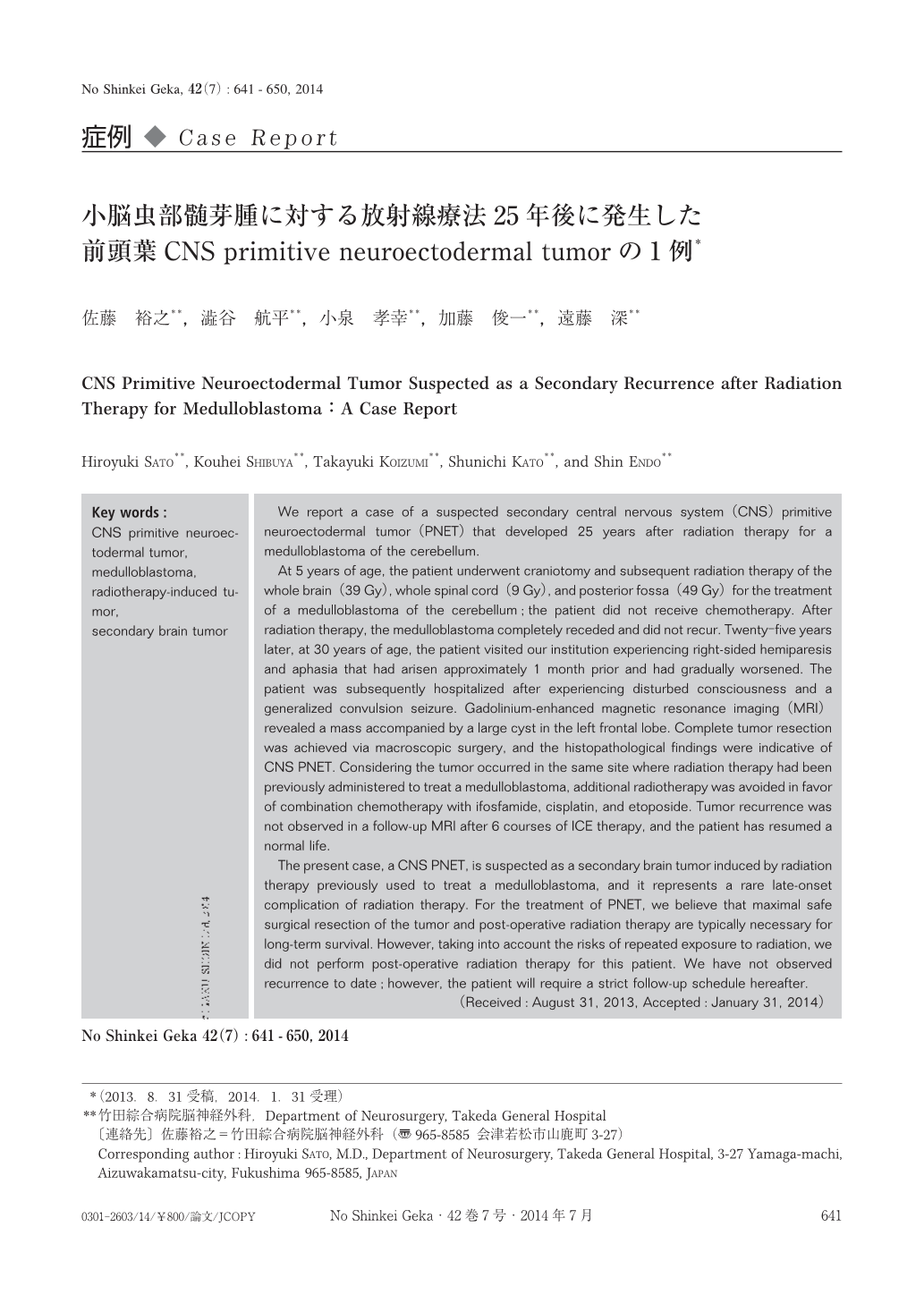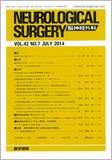Japanese
English
- 有料閲覧
- Abstract 文献概要
- 1ページ目 Look Inside
- 参考文献 Reference
Ⅰ.はじめに
中枢神経系primitive neuroectodermal tumor(CNS PNET)は未分化な神経上皮性腫瘍からなり,神経細胞,グリア,上皮細胞などへの多様な潜在的分化能をもつ腫瘍である.WHO gradeⅣであり,組織学的に類似した髄芽腫とともに胎児性脳腫瘍である.発生母地としては,Rorke20)は胎生期に盛んに分裂増殖している脳室周囲細胞であるgerminal matrix cellが起源であると推定し報告している.1973年にHartとEarle11)によって,①幼少期に好発,②臨床的に悪性,③大脳に発生,④肉眼的に囊胞状,出血性で境界明瞭,⑤顕微鏡的に悪性,全体的に未分化で一部グリア細胞や神経細胞への分化傾向を認め,⑥著明な間質成分という特徴を有し,90~95%以上が未分化の細胞からなる腫瘍として提唱された.
一方,髄芽腫治療後長期生存例が増えるにつれて,二次新生物,とりわけ二次性脳腫瘍の報告は増えてきている.
今回われわれは,髄芽腫に対する放射線治療25年後に発症した放射線誘発性が疑われる二次性脳腫瘍としてのCNS PNET症例を経験したので,文献的考察を加えて報告する.
We report a case of a suspected secondary central nervous system(CNS)primitive neuroectodermal tumor(PNET)that developed 25 years after radiation therapy for a medulloblastoma of the cerebellum.
At 5 years of age, the patient underwent craniotomy and subsequent radiation therapy of the whole brain(39Gy), whole spinal cord(9Gy), and posterior fossa(49Gy)for the treatment of a medulloblastoma of the cerebellum;the patient did not receive chemotherapy. After radiation therapy, the medulloblastoma completely receded and did not recur. Twenty-five years later, at 30 years of age, the patient visited our institution experiencing right-sided hemiparesis and aphasia that had arisen approximately 1 month prior and had gradually worsened. The patient was subsequently hospitalized after experiencing disturbed consciousness and a generalized convulsion seizure. Gadolinium-enhanced magnetic resonance imaging(MRI)revealed a mass accompanied by a large cyst in the left frontal lobe. Complete tumor resection was achieved via macroscopic surgery, and the histopathological findings were indicative of CNS PNET. Considering the tumor occurred in the same site where radiation therapy had been previously administered to treat a medulloblastoma, additional radiotherapy was avoided in favor of combination chemotherapy with ifosfamide, cisplatin, and etoposide. Tumor recurrence was not observed in a follow-up MRI after 6 courses of ICE therapy, and the patient has resumed a normal life.
The present case, a CNS PNET, is suspected as a secondary brain tumor induced by radiation therapy previously used to treat a medulloblastoma, and it represents a rare late-onset complication of radiation therapy. For the treatment of PNET, we believe that maximal safe surgical resection of the tumor and post-operative radiation therapy are typically necessary for long-term survival. However, taking into account the risks of repeated exposure to radiation, we did not perform post-operative radiation therapy for this patient. We have not observed recurrence to date;however, the patient will require a strict follow-up schedule hereafter.

Copyright © 2014, Igaku-Shoin Ltd. All rights reserved.


